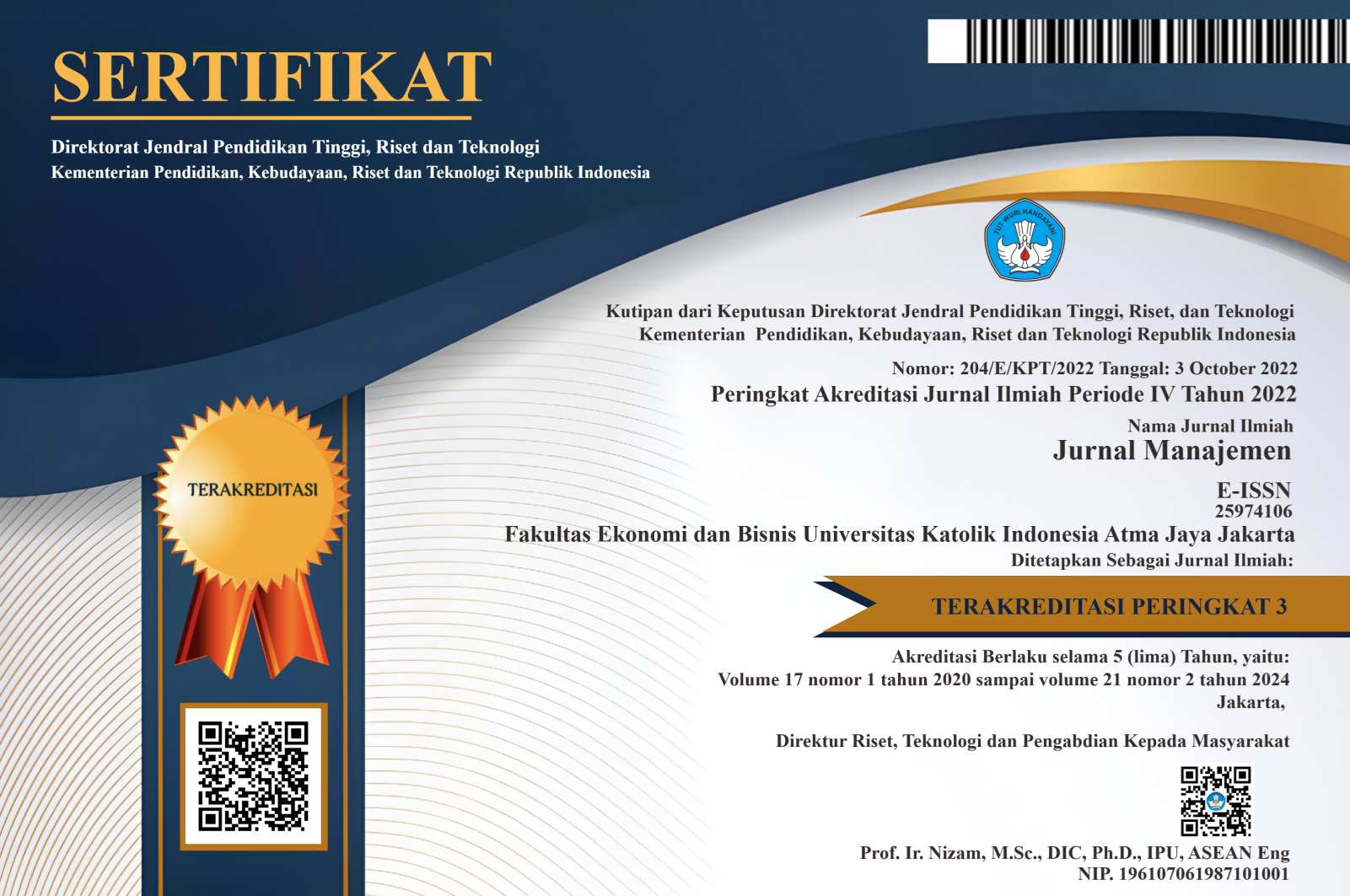STRATEGIC BUSINESS TRANSFORMATION AND CORPORATE SUSTAINABILITY: EXAMINING THE ROLE OF DYNAMIC AND DIGITAL CAPABILITIES
DOI:
https://doi.org/10.25170/jm.v22i1.6577Kata Kunci:
Business Transformation, Service Innovation, Dynamic Capability, Digital Transformation, Corporate SustainabilityAbstrak
In today's dynamic and competitive business environment, organizations must continuously adapt to external and internal changes to achieve corporate sustainability. This study examines the influence of Business Transformation (BT), Service Innovation Capability (SIC), and Service Delivery (SD) on Corporate Sustainability (CS), with Dynamic Capability (DC) as a mediating variable and Digital Transformation (DT) as a moderate factor. Employing Resource-Based View (RBV) and Market-Based View (MBV) theories, this study aims to explore how firms leverage internal capabilities and external market factors to drive long-term sustainability. A quantitative research design was applied, utilizing "This study employed Partial Least Squares-Structural Equation Modeling (PLS-SEM) to test the proposed hypotheses, utilizing data collected from 400 managers." and executives in the energy sector, with a focus on PT PLN (Persero). The findings confirm that BT, SIC, and SD positively influence CS, both directly and indirectly through DC. Furthermore, DT significantly moderates the relationships between BT, SIC, and SD with DC, indicating that digital adoption enhances firms' ability to adapt and reconfigure resources. The mediating role of DC was also supported, reinforcing its importance in linking strategic initiatives to sustainability outcomes. This study contributes to strategic management literature by integrating RBV and MBV perspectives while providing empirical evidence on DT as a catalyst for corporate sustainability. Practically, the results highlight the importance of firms investing in digital capabilities.", service innovation, and dynamic adaptation strategies to remain competitive. Future research should explore longitudinal effects and industry variations in digital transformation and sustainability practices.
Referensi
Akbari, M., Nobari, N., Mokhtari, H., Padash, H., & Moradi, A. (2022). Exploring the Co- Effect of Market Orientation and Ambidextrous Innovation in Service Innovation of SMEs. Iranian Journal of Management Studies, 15(4), 663–682. https://doi.org/10.22059/IJMS.2021.328741.674711
Barney, J. (1991). Firm Resources and Sustained Competitive Advantage. Journal of Management, 17(1), 19–120.
Blichfeldt, H., & Faullant, R. (2021). Performance effects of digital technology adoption and product & service innovation–A process-industry perspective. Technovation, 105.
Bustinza, O. F., Vendrell-Herrero, F., & Chiappetta Jabbour, C. J. (2024). Integration of product-service innovation into green supply chain management: Emerging opportunities and paradoxes. Technovation, 130. https://doi.org/10.1016/j.technovation.2023.102923
George, G., & Sichillebeeckx, S. J. (2022). Digital transformation, sustainability, and purpose in the multinational enterprise. Journal of World Business, 57(3), 101326.
Gonçalves, A. M., Moreira, A., Weber, A., Williams, G. R., & Costa, P. F. (2021). Osteochondral tissue engineering: The potential of electrospinning and additive manufacturing. Pharmaceutics, 13(7), 983.
Hanaysha, J. R., Al-Shaikh, M. E., Joghee, S., & Alzoubi, H. M. (2022). Impact of Innovation Capabilities on Business Sustainability in Small and Medium Enterprises. FIIB Business Review, 11(1), 67–78. https://doi.org/10.1177/23197145211042232
Imam, H., & Zaheer, M. K. (2021). NShared leadership and project success: The roles of knowledge sharing, cohesion and trust in the teamo Title. International Journal of Project Management, 39(5), 463–473.
Mohamed Hashim, M. A., Tlemsani, I., & Matthews, R. (2022). Higher education strategy in digital transformation. Education and Information Technologies, 27(3), 3171–3195.
Nacken, T., Karreman, B., & Pennings, E. (2024). Addressing endogeneity in the relationship between early entry and performance: The case of foreign market expansion. Long Range Planning, 57(6). https://doi.org/10.1016/j.lrp.2024.102478
Patel, J., More, S., Sohani, P., Bedarkar, S., Dinesh, K. K., Sharma, D., Dhir, S., Sushil, S., & Ghosh, R. S. (2024). Reshaping the equitable and inclusive access to healthcare: A qualitative study. Clinical Epidemiology and Global Health, 26. https://doi.org/10.1016/j.cegh.2024.101544
Porter, M. E. (1985). Competitive Advantage: Creating and Sustaining Superior Performance. Free Press.
Probojakti, W., Utami, H. N., Prasetya, A., & Riza, M. F. (2025). Driving sustainable competitive advantage in banking: The role of transformational leadership and digital transformation in organizational agility and corporate resiliency. Business Strategy and the Environment.
Putritamara, J. A., Hartono, B., Toiba, H., Utami, H. N., Rahman, M. S., & Masyithoh, D. (2023). Do Dynamic Capabilities and Digital Transformation Improve Business Resilience during the COVID-19 Pandemic? Insights from Beekeeping MSMEs in Indonesia. Sustainability, 15(3), 1760.
Quille, R. V. E., Almeida, F. V. D., Borycz, J., Corrêa, P. L. P., Filgueiras, L. V. L., Machicao, J., Almeida, G. M. D., Midorikawa, E. T., Demuner, V. R. D. S., Bedoya, J. A. R., Bedoya, J. A. R., & Vajgel, B. (2023). Performance Analysis Method for Robotic Process Automation. Sustainability (Switzerland), 15(4). https://doi.org/10.3390/su15043702
Satar, A., Al Musadieq, M., Hutahayan, B., & S. (2023). Enhancing Sustainable Competitive Advantage: The Role of Dynamic Capability and Organizational Agility in Technology and Knowledge Management: Indonesian Stock Exchange Evidence. International Journal of Operations and Quantitative Management, 29(1), 2023.
Schaltegger, S., Hansen, E.G., & Lüdeke-Freund, F. (2022). Business models for sustainability: The drivers and barriers to sustainable business model innovation. Journal of Cleaner Production, 371, 133498.
Sharma, M., Alkatheeri, H., Jabeen, F., & Sehrawat, R. (2022). Impact of COVID-19 pandemic on perishable food supply chain management: a contingent Resource-Based View (RBV) perspective. The International Journal of Logistics Management, 33(3), 796–817.
Soebandrija, K. E. N., & Sahroni, T. R. (2021). The New Normal and Sustainability Perspectives on Industrial Engineering and Professional Engineering. IOP Conference Series: Earth and Environmental Science, 794(1). https://doi.org/10.1088/1755- 1315/794/1/012088
Su, R., Obrenovic, B., Du, J., Godinic, D., & Khudaykulov, A. (2022). COVID-19 Pandemic Implications for Corporate Sustainability and Society: A Literature Review. International Journal of Environmental Research and Public Health, 19(3). https://doi.org/10.3390/ijerph19031592
Trad, A. (2021). The business transformation framework and enterprise architecture framework for managers in business innovation: An applied holistic mathematical model. International Journal of Service SICience, Management, Engineering, and Technology (IJSSMET), 12(1), 142–181.
Weerakkody, V., El-Haddadeh, R., Sivarajah, U., Omar, A., & Molnar, A. (2022). A case analysis of E-government service delivery through a service chain dimension. International Journal of Information Management, 47, 233–238.
Wu, Q., Yan, D., & Umair, M. (2023). Assessing the role of competitive intelligence and practices of dynamic capabilities in business accommodation of SMEs. Economic Analysis and Policy, 77, 1103–1114.
Zhang, Y., & Jin, S. (2023). Does digital transformation increase corporate sustainability? The moderating role of top management teams. Systems, 11(7), 355
Unduhan
Diterbitkan
Terbitan
Bagian
Lisensi
Hak Cipta (c) 2025 Patar Situmorang, John Tampil Purba, Evo Sampetua Hariandja

Artikel ini berlisensiCreative Commons Attribution-NonCommercial-ShareAlike 4.0 International License.
Authors who publish with this journal agree to the following terms:
Authors retain copyright and grant the journal right of first publication with the work simultaneously licensed under a Creative Commons Attribution-NonCommercial-ShareAlike License that allows others to share the work with an acknowledgement of the work's authorship and initial publication in this journal.
Authors are able to enter into separate, additional contractual arrangements for the non-exclusive distribution of the journal's published version of the work (e.g., post it to an institutional repository or publish it in a book), with an acknowledgement of its initial publication in this journal.
Authors are permitted and encouraged to post their work online (e.g., in institutional repositories or on their website) prior to and during the submission process, as it can lead to productive exchanges, as well as earlier and greater citation of published work (See the Effect of Open Access).












